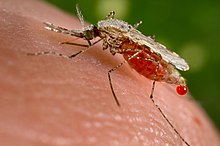Disease vector

In epidemiology, a vector is an insect or any living carrier that transmits an infectious agent.[1][2][page needed] Vectors are vehicles by which infections are transmitted from one host to another. Most commonly known vectors consist of arthropods, domestic animals, or mammals that assist in transmitting parasitic organisms to humans or other mammals. A vector is not only required for part of the parasite's developmental cycle, but it also transmits the parasite directly to subsequent hosts.
Insects as vector

Arthropods form a major group of disease vectors with mosquitoes, flies, sand flies, lice, fleas, ticks, mites and cyclops transmitting a huge number of diseases. Many such vectors are haematophagous, meaning they feed on blood at some or all stages of their lives. When the insects blood feed, the parasite enters the blood stream of the host. This can happen in different ways. The Anopheles mosquito, a vector for Malaria, Filariasis and various arthropod-borne-viruses (arboviruses), inserts its delicate mouthpart under the skin and feeds on its hosts blood. The parasites the mosquito carries are usually located in its salivary glands (used by mosquitoes to anaesthetise the host). Therefore, the parasites are transmitted directly into the hosts blood stream. Pool feeders such as the sand fly and black fly, vectors for Leishmaniasis and Onchocerciasis respectively, will chew a well in the host's skin, forming a small pool of blood from which they feed. Leishmania parasites then infect the host through the saliva of the sand fly. Onchocerca force their own way out of the insect's head into the pool of blood. Triatomine bugs are responsible for the transmission of a trypanosome, Trypanosoma cruzi, which causes Chagas' Disease. The Triatomine bugs defecate during feeding and the excrement contains the parasites which are accidentally smeared into the open wound by the host responding to pain and irritation from the bite.
Examples of vectors
- Fleas, typically human fleas such as Pulex and Xenopsylla transmit bubonic plague.
- Mosquitoes of the Anopheles genus transmit human malaria
- Aedes mosquitoes are vectors of avian malaria, dengue fever, yellow fever and chikungunya
- Several genera of Tsetse flies are vectors of human African trypanosomiasis also known as "African sleeping sickness"
- Triatomine bugs are vectors of Chagas disease
- Ticks of the genus Ixodes are vectors of Lyme disease and babesiosis
- Phlebotomine sand flies transmit leishmaniasis, bartonellosis, sandfly fever and pappataci fever.
- Numerous species of ticks and lice transmit various members of the bacterial genus Rickettsia
- The crustacean cyclops transmit the nematode Dracunculus medinensis.
See also
References
Template:P 672, Parks , Text book of Social & Prevntive Medicine, Author K Park, Jabalpur India 2009
This article needs additional citations for verification. (September 2009) |
- ^ Last, James, ed. (2001). A Dictionary of Epidemiology. New York: Oxford University Press. p. 185. ISBN 978-0195141696. OCLC 207797812.
- ^ Roberts, Larry S.; John, Janovy; Gerald D., Schmidt (2008). Foundations of Parasitology. McGraw Hill. ISBN 978-0073028279. OCLC 226356765.
